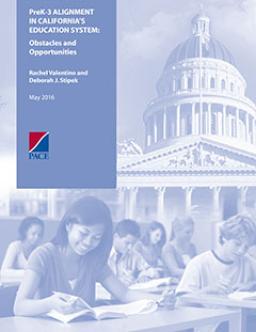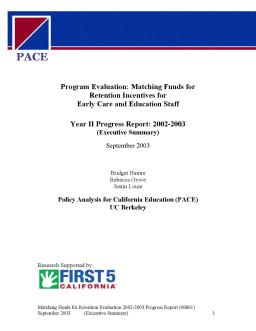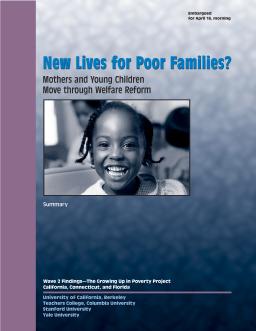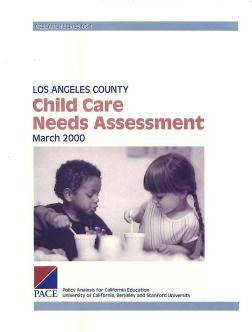Views from the 2019 PACE/USC Rossier Poll
Published
Summary
With a new governor, state superintendent and legislators in Sacramento and a diminished federal role in education, there is an opportunity for California’s leaders to take stock of recent educational reforms and make necessary improvements. There are also a host of new and looming issues in K-12 and higher education. As California’s leaders confront these and other issues, where do California voters, including parents, stand on education and education policy? The newest edition of the USC Rossier/PACE Poll shares voter perspectives on a wide range of education issues.
Challenges and Possibilities
Published
Summary
In recent years, California has invested in improving early childhood education programs. Research shows the importance of high-quality early childhood education, but the disconnect from K–12 education threatens its long-term benefits. If the early grades do not build on the gains made in preschool, they likely will be lost. This brief, based on a longer technical report , describes the challenges facing pre-K–3 alignment and off ers promising practices and policy recommendations.
Obstacles and Opportunities
Published
Summary
Over the past several years, there has been much attention and advocacy around “PreK-3 Alignment,” both in California and nationwide. The push for alignment comes in the face of a growing body of research documenting the benefits of attending high quality preschool, along with concerns about the fading of the benefits of preschool by third grade that has been found in many studies. Supporters of preK-3 alignment note that child development is a continuous process, and that skills developed in one grade must be built upon and reinforced in later grades.
Five Years Later
Published
Summary
This report commemorates the fifth anniversary of the Getting Down to Facts project, which sought to provide a thorough and reliable analysis of the critical challenges facing California’s education system as the necessary basis for an informed discussion of policy changes aimed at improving the performance of California schools and students. The report focuses on the four key issues that received emphasis in the Getting Down to Facts studies: governance, finance, personnel, and data systems.
The Influence of Preschool Centers on Children’s Development Nationwide
Published
Summary
This report examines the effects of preschool or childcare exposure on cognitive and social development before kindergarten, focusing on intensity and duration of attendance, and how this varies across different income and ethnic groups. The authors utilize data from a nationally representative sample of young children with rich family background information. Findings are important for debates over extending free preschool and which groups of children would most benefit.
Year Two Progress Report, 2002–03—Executive Summary
Published
Summary
This report highlights findings from a 2002-03 progress report on First 5 California's childcare retention incentive programs, aimed at improving retention and increasing training among early care and education staff. Data were collected from ten counties through a phone survey of participants and site visits. Initial findings related to program design and implementation, program participation, training and professional development, and retention are summarized.
Mothers and Young Children Move Through Welfare Reform
Published
Summary
This report discusses the lack of knowledge about the impact of welfare-to-work programs on young children since 1996, and how policy leaders are debating ways to aid jobless mothers and enrich their children's lives. The project team followed 948 mothers and preschool-age children for two to four years after the women entered new welfare programs in California, Connecticut, and Florida.
Mothers and Young Children Move Through Welfare Reform: Executive Summary
Published
Summary
This report examines how welfare-to-work programs have affected the lives of young children since 1996, and how they've impacted the home and childcare settings in which they are raised. The study followed 948 mothers and preschool-age children in California, Connecticut, and Florida for two to four years, using interviews, assessments, and visits to homes and childcare settings. The report highlights the major findings from the study.
Year 1—Qualitative Implementation Study
Published
Summary
This report on San Francisco County’s CARES program (SF CARES) provides guidance for policymakers, program administrators, and childcare advocates planning similar initiatives. PACE collected feedback from program planners, stipend recipients, and other childcare community members on aspects of the planning and implementation process. SF CARES successfully distributed over 400 stipends in the program’s first year, but challenges remain in reaching a broader array of childcare providers and communicating program goals.
Year 1—Qualitative Implementation Study
Published
Summary
This report provides guidance on implementing childcare retention initiatives based on Alameda County’s Child Development Corps program. PACE conducted focus groups with stakeholders to gather feedback on the planning and implementation process. The program saw increased commitment from providers to their profession and seeking training opportunities, but challenges remain with fitting permit requirements to family providers and relevance of courses.
Published
Summary
A study conducted for the Los Angeles County Department of Public Social Services aimed to determine the supply and demand of licensed childcare in the county, with a focus on low-income communities and special types of care. The survey analyzed data at three levels: county-wide, service planning areas, and supervisorial districts. Results showed disparities in childcare supply across the county, with shortages in special types of care and little information on where childcare is needed.
Mothers Balance Work and Child Care Under Welfare Reform—Executive Summary
Published
Summary
A four-year study aimed to learn how welfare reform affects children's upbringing and development, showing early warning signals such as low-quality childcare and social isolation among women. The report provides a baseline picture for 948 families across three states and suggests an unfinished agenda for cash assistance and family support programs to lift children out of poverty.











